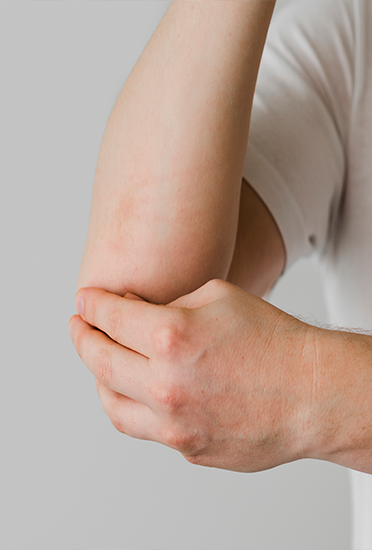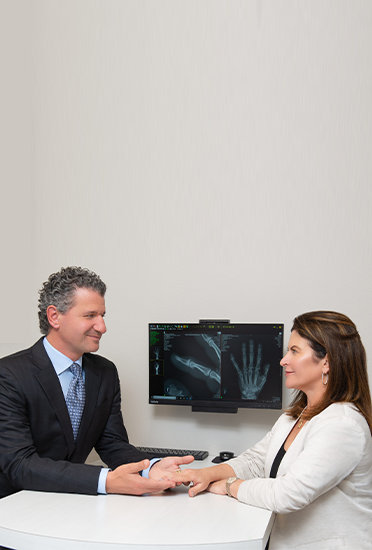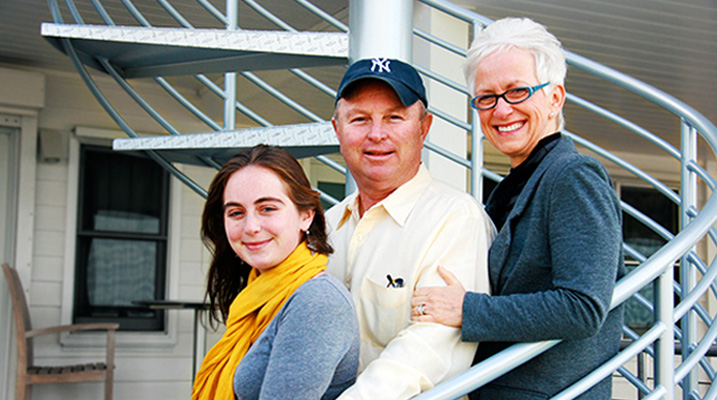Knee Arthritis Treatment

Age plays a crucial role in the development of knee osteoarthritis; however, even young people can develop it. Hereditary factors may be at play for some people, while others may experience knee arthritis due to injury or infection, or excessive weight.
Whatever type of knee condition you have or which knee arthritis treatment option you choose, staying informed about your condition and working with an experienced doctor to ensure you get the best care for your needs is critical.
What is Knee Arthritis?
Knee arthritis is a condition that causes pain and decreased mobility due to the gradual deterioration of the cartilage in the knee joint. Various elements, such as age, genetics, and trauma, can trigger the development of this condition.
Symptoms may include:
- Pain and stiffness in the knee joint.
- Swelling around the joint.
- The difficulty in movement or bearing weight on the affected leg.
In people with arthritic conditions, the bone may rub against the bone, forming bony protrusions known as bone spurs. Prolonged deterioration of joint cartilage can wreak havoc on knee structure leading to knock-knee and bowed leg deformities.

Types of Knee Arthritis
- Osteoarthritis of the Knee: Osteoarthritis of the knee is a type of degenerative arthritis that causes the knee joint cartilage to wear away, resulting in pain and stiffness. It is most commonly caused by age-related wear and tear or genetic factors.
- Rheumatoid Arthritis of the Knee: Rheumatoid Arthritis of the Knee develops when the immune system attacks the knee joint’s cartilage, causing inflammation and pain.
- Post-Traumatic Knee Arthritis: This Arthritis is caused by a direct blow or injury to the knee joint, which damages the cartilage and leads to pain. In some cases, this type of arthritis can even develop years after an initial injury.

Symptoms of Knee Arthritis
For those suffering from knee arthritis, even the simplest of tasks can be incredibly painful and laborious, such as walking or climbing stairs. So look out for the following simple indicators of arthritis in the knee:
- Pain in the knee: Knee arthritis can cause pain, swelling, and stiffness in the joint. Pain may range from a mild ache to a sharp or burning sensation worse when bearing weight on the leg.
- Stiffness of the knee: Stiffness can make moving or bending the knee joint difficult, limiting the range of motion.
- Swelling in the knee joint: Swelling is often present in cases of arthritis and warmth or redness around the joint.
- Catching and locking of the knee: Catching, locking, and crepitus (grinding noises) may also occur when moving the knee joint.
- Crepitus (grinding) of the knee: Crepitus is created when cartilage in the knee joint wears away, leaving bone rubbing against bone.
- Redness and warmth around the knee: Redness and warmth around the joint can indicate inflammation caused by arthritis.
- Weakness in the knee: Weakness in the knee can make it difficult for you to stand or walk for long periods.
- Difficulty bearing weight on the affected leg– It may be difficult to bear weight on the affected leg if the knee joint has been damaged by arthritis.
- Range of motion difficulty: Difficulties in moving the joint can lead to decreased range of motion.

If left untreated, knee arthritis can lead to significant pain and disability. Therefore, it is critical to consult a doctor about any symptoms you are experiencing so that the proper diagnosis can be made and treatment can begin. Early diagnosis and treatment of knee arthritis can help reduce long-term damage and improve the overall quality of life.
Your doctor may prescribe you NSAIDs, corticosteroids, or physical therapy, depending on the type, severity, and progression of your knee condition. Alternative therapies may also be considered including a multitude of injections.
What Are the Risk Factors of Knee Arthritis
Below are some of the risk factors of Knee Arthritis:
- Age: Age is a leading risk factor for knee arthritis. The knee joint cartilage wears down and becomes less effective at cushioning the bones as they move against each other as we age. Furthermore, the ligaments and tendons that support the knee can weaken with age, resulting in joint instability.
- Heredity: Heredity also plays a role in knee arthritis, as some people may be more prone to the condition due to genetic factors.
Excess weight: Excess weight puts additional strain on the knee joint and can increase the risk of developing arthritis.
Injury: Injuries like fractures or ligament tears are another risk factor for knee arthritis. Such trauma can harm the joint and surrounding tissues, resulting in long-term degenerative changes. - Autoimmune triggers: Autoimmune triggers, such as rheumatoid arthritis, may also contribute to knee pain and stiffness.
- Occupational stress: Repetitive strain due to occupation can cause wear and tear on the knee joint over time.
It is recommended to talk with your doctor if you notice any of these risk factors to determine the best knee arthritis treatment plan for your needs.
How is Knee Arthritis Diagnosed?
Diagnosis of knee arthritis typically involves a doctor’s physical examination, laboratory tests, and imaging studies. During the physical exam, your doctor will assess a few things, including:
- The range of motion in the joint.
- Any swelling or tenderness in the area.
- They may also order X-rays for joint space narrowing caused by cartilage deterioration.
- Blood tests may be performed to check inflammation and/or autoimmune triggers contributing to knee arthritis, which may be initiated by your orthopedic surgeon but are typically managed by a rheumatologist.
Charles E. Stewart, M.D., a board-certified orthopedic surgeon, will perform a full examination to determine the extent of your injury and recommend a personalized treatment plan. To establish if you have knee arthritis, he will utilize a variety of diagnostic tests and procedures, such as:
Medical history and physical examination: A comprehensive assessment of medical history and physical examination is paramount for a successful diagnosis.
Blood tests: Genetic markers and RA antibody blood tests can provide vital information about your health.
X-rays: It helps determine cartilage loss in the knee and can reveal the degree of cartilage deterioration, allowing accurate diagnosis and treatment.

Joint aspiration: Sampling and examining the synovial fluid inside the knee joint through an aspiration process may be essential for understanding any underlying issues within this crucial joint.
Charles E. Stewart, M.D. is a board-certified orthopedic surgeon specializing in reconstructive treatments for the adult lower extremity. He will be able to determine a proper diagnosis and treatment plan based on the results of these tests.
How is Knee Arthritis Treated?
Depending on your age, the level of agony you are in, the stage and type of arthritis you have, and other elements, treatment strategies differ. Sadly, cartilage breakdown cannot be reversed; however, there are ways to ease aches and prevent further harm.
Nonsurgical treatments for knee arthritis
Your doctor may suggest the following nonsurgical treatments for knee arthritis:
Simple Life Changes: Modifying your activities can help prevent joint pain and inflammation from worsening.
This change may involve avoiding high-impact exercises like running and jumping and instead focusing on low-impact or no-impact exercises to remain physically active and manage symptoms. “Motion is lotion.”
Physical Therapy: Physical therapy may help increase strength and range of motion in the knee joint.
Weight Loss: If applicable, your doctor may suggest weight loss to reduce the stress placed on the joint. The forces across the knee are up to 4-8X body weight. Thus even moderate weight loss can help ease symptoms.
Bracing: Bracing can provide additional support and stability to the joint.
Medications: Medications and injections like hyaluronic acid injections can be prescribed to control pain and inflammation and promote healing.
Walking Aids: Walking aids like a cane or walker can be used to provide support.
The advancement of knee arthritis and the success of nonsurgical treatments can differ. For this, your doctor will collaborate with you to create a customized plan that might involve a mix of nonsurgical treatments.

Knee Arthritis Surgery
If nonsurgical treatments do not offer sufficient pain relief and improvement in mobility, consider surgical alternatives after consulting your doctor. These may include:
Radiofrequency ablation: It helps block pain signals from reaching the brain.
Total knee replacement: It involves replacing the knee joint’s bones with artificial implants for long-term stability and pain reduction.
Partial knee replacement or resurfacing: This procedure addresses cartilage damage in a specific knee area.
Arthroscopic Surgery: Or minimally invasive “clean-out surgery, that was popular many years ago involves removing the joint lining damaged by rheumatoid arthritis.
What is the Recovery Time of Knee Arthritis Treatment?
Following any knee arthritis surgery, there is a recovery phase. The recovery from knee arthritis will depend upon your treatment type.
Your orthopedic surgeon may suggest physical therapy to help you gain knee strength and restore motion range. You might require a knee brace, crutches, or a cane for a certain duration based on the type of knee surgery. Surgery helps alleviate pain and improves your ability to perform everyday activities easily.
While it typically takes around six weeks for the muscles to recover and support the joint, after three months fully, you should have enough strength to go back to work and begin some light sports. Maintain your optimism, but don’t be disheartened if recovery takes longer. Patients will continue to make improvements for 1-2 years.
The success of a joint replacement procedure is determined by various factors, such as your
- Age
- Muscle strength
- Overall wellness
- The type of joint being replaced
- Your motivation to complete physical therapy.

In the initial three-month period after surgery, you should abstain from actions such as squatting and kneeling for extended periods, carrying heavy items, and making sudden forceful movements. Additionally, removing tripping hazards inside your home requires wearing flat, well-fitting shoes with non-slippery soles to avoid falls.
Conclusion:
Knee arthritis is a common problem affecting people of all ages. Therefore, it is necessary to understand the risk factors, diagnosis, treatment options, and prevention strategies for knee arthritis to make informed decisions about your health.
If you have signs and symptoms of knee arthritis, it’s best to consult a medical professional immediately. Let our experienced and board-certified orthopedic surgeon provide customized treatment for a successful recovery from knee arthritis. Are you looking for more information? Book an appointment at Charles E. Stewart M.D. – Sforzo | Dillingham | Stewart Orthopedics + Sports Medicine.
Conditions Knees
Treatment Knees
Focusing On You
As healthcare is ever changing, Sforzo | Dillingham | Stewart Orthopedics + Sports Medicine, is doing things differently…
-
 Christopher R. Sforzo, M.D. is a board certified orthopedic surgeon and fellowship trained in hand and upper extremity surgery. He provides expert care in the treatment of problems involving the shoulder, arm, elbow, forearm, wrist and hand. He performs many procedures using minimally invasive techniques includi
Christopher R. Sforzo, M.D. is a board certified orthopedic surgeon and fellowship trained in hand and upper extremity surgery. He provides expert care in the treatment of problems involving the shoulder, arm, elbow, forearm, wrist and hand. He performs many procedures using minimally invasive techniques includi -
 Christopher L. Dillingham, M.D. is a board certified orthopedic surgeon and fellowship trained in hand, shoulder, and arm surgery. He specializes in the treatment of problems with rotator cuff disorders, carpal tunnel syndrome and nerve injury, joint replacement, arthritis surgery, fracture repair, foot and ankle
Christopher L. Dillingham, M.D. is a board certified orthopedic surgeon and fellowship trained in hand, shoulder, and arm surgery. He specializes in the treatment of problems with rotator cuff disorders, carpal tunnel syndrome and nerve injury, joint replacement, arthritis surgery, fracture repair, foot and ankle -
 Charles E. Stewart M.D. is a board certified, Johns Hopkins fellowship-trained orthopedic surgeon specializing in adult complex reconstruction of the lower extremity. His specialties include, lower extremity sports injuries, meniscal injuries, partial knee replacement, total hip and knee arthroplasty (replacement), as
Charles E. Stewart M.D. is a board certified, Johns Hopkins fellowship-trained orthopedic surgeon specializing in adult complex reconstruction of the lower extremity. His specialties include, lower extremity sports injuries, meniscal injuries, partial knee replacement, total hip and knee arthroplasty (replacement), as -
 Philip A. Meinhardt, M.D. is a board certified orthopedic surgeon and fellowship trained spine surgeon. He specializes in adult spinal surgeries including reconstruction of spinal deformities, minimally invasive/microscopic spinal procedures, decompression, spinal instrumentation, fusion procedures and microscopic cer
Philip A. Meinhardt, M.D. is a board certified orthopedic surgeon and fellowship trained spine surgeon. He specializes in adult spinal surgeries including reconstruction of spinal deformities, minimally invasive/microscopic spinal procedures, decompression, spinal instrumentation, fusion procedures and microscopic cer
Testimonial
Latest Blog Posts
-
 October 18, 2022Dr. Christopher Sforzo was invited to speak at the recent IMG Academy Athlet
October 18, 2022Dr. Christopher Sforzo was invited to speak at the recent IMG Academy Athlet -
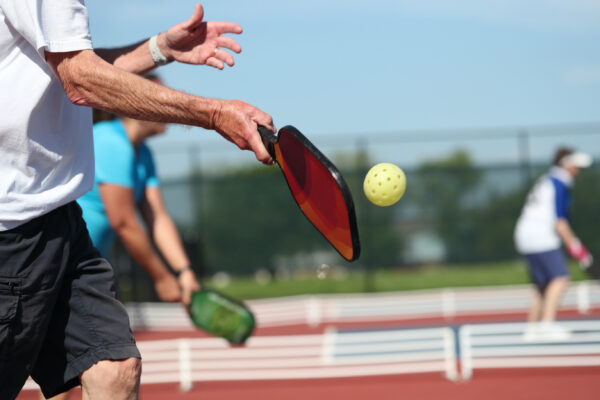 January 22, 2022Did you know that pickleball has become the fastest-growing sport in the U.S.? It’s a fun
January 22, 2022Did you know that pickleball has become the fastest-growing sport in the U.S.? It’s a fun -
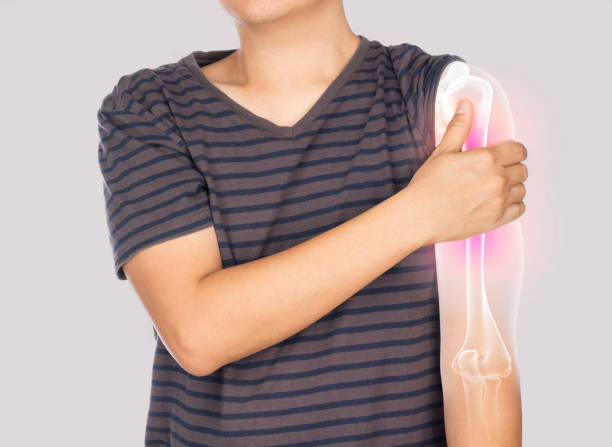 October 27, 2021SARASOTA, FL – With the fall football season underway, shoulder injuries are on the rise among
October 27, 2021SARASOTA, FL – With the fall football season underway, shoulder injuries are on the rise among


